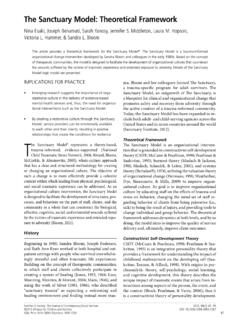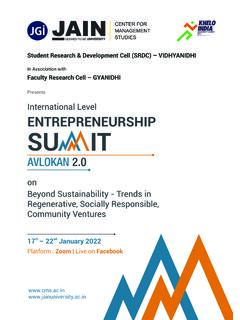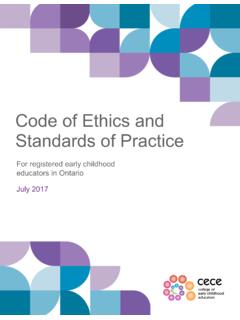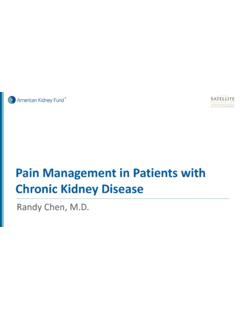Transcription of THRIVE Guide to Trauma-Informed Organizational …
1 THRIVE 2010 Page 1 Guide to TraumaGuide to TraumaGuide to TraumaGuide to trauma ---- informed informed informed informed Organizational DevelopmentOrganizational DevelopmentOrganizational DevelopmentOrganizational Development THRIVE 2010 Page 2 Acknowledgements The THRIVE Initiative wishes to acknowledge the work of Trauma-Informed pioneers without which this Guide and transformational work would not be possible. This information is derived from the works of Roger Fallot, PhD and Maxine Harris, of Community Connectionsi, the National Center on Family Homelessness s Trauma-Informed Organizational Toolkitii, the Connecticut Women s Consortiumiii . THRIVE family, youth and stakeholders have also provided invaluable insight to ensure that the Guide is family driven and youth guided.
2 The Guide to Trauma-Informed Organizational Development is designed to help agencies develop strategies to create and enhance Trauma-Informed system of care service approaches. It is not all inclusive, nor is it intended to be a one size fits all approach to becoming Trauma-Informed . The intent is to provide agencies with information on the options and approaches currently available in the children s mental health field on Trauma-Informed service delivery. THRIVE 2010 Page 3 Table of Contents 1. STAGES OF IMPLEMENTATION .. 4 2. CONTINUOUS QUALITY IMPROVEMENT .. 8 3. PRIORITY MATRIX .. 9 4. DOMAIN 1: SAFETY .. 10 5. DOMAIN 2: YOUTH AND FAMILY EMPOWERMENT, CHOICE AND COLLABORATION .. 12 6. DOMAIN 3: trauma COMPETENCE .. 16 7.
3 DOMAIN 4: TRUSTWORTHINESS .. 19 8. DOMAIN 5: COMMITMENT TO Trauma-Informed PHILOSOPHY .. 21 9. DOMAIN 6: LANGUAGE ACCESS AND CULTURAL COMPETENCE .. 25 10. YOUTH AND FAMILY PERSPECTIVES .. 29 11. TECHNICAL ASSISTANCE RESOURCES .. 36 THRIVE 2010 Page 4 Stages of Implementation Becoming a Trauma-Informed agency means making a commitment to changing the practices, policies, and culture of an entire organization. This type of change requires that staff at all levels and in all roles modify what they do based on an understanding of the impact of trauma and the specific needs of trauma survivors. This process takes time and requires that an agency understand the stages of change and how to identify its own strengths and challenges.
4 This process varies from agency to agency and requires both adaptive and technical solutions. One training will not result in an agency becoming Trauma-Informed . The following are suggested implementation steps: Steps may look different depending on whether your agency has completed the Trauma-Informed Agency Assessment (TIAA) which is now a Maine state requirement for agencies contracting with Children s Behavioral Health Services. If your agency was not required to complete this assessment or you were unable to complete the assessment you will have an additional step to complete. Step 1: The program or agency identifies a person or a group of people who have the desire to assist their organization in becoming Trauma-Informed . This group is known as the Trauma-Informed change team.
5 At least one of these people is in a position of authority to make system wide changes in the program. These are the champions for change in your organization and should represent a variety of roles/disciplines in your agency. It is recommended that administrators, direct care staff, support staff and human resources staff be represented on this team and that the team not exceed 10 individuals. These individuals will review the results of the Trauma-Informed Agency Assessment (TIAA) if the agency participated in the completion of the assessment. For agencies that did not complete the TIAA, it is recommended that you still form a team that can assist your organization with identifying strategies to complete the assessment. Important Tips to Consider: It is helpful to have more than one leader identified as a champion for change so that it is not the responsibility of one individual to make change happen.
6 Leaders must have the authority to make change happen and should be given the time in their work life to devote to the change process. This is not a clinical only process. Successful change happens when human resources and operations is included in the discussion. Examples for team members: Human resource director, clinical manager, direct care staff, manager of records, reception supervisor, maintenance Families, youth, and adult consumers (if applicable to your agency) should be included in this discussion as an advisory group or as members of the team. Please note that if families and youth are asked to join the team that the team first look at how the team can be youth and family friendly, time of meeting, clinical jargon, power imbalance.
7 Consulting with a family or youth organization may be helpful. (See resource Guide for contact information for Youth MOVE Maine and ) THRIVE 2010 Page 5 Consider naming this group the Trauma-Informed change team rather than a workgroup, and establish clear deliverables and timelines based on the results of the TIAA. If your agency did not complete the TIAA consider the steps you would undertake to complete the assessment and create a training plan to support the organization. Work with a Trauma-Informed consultant(s) to assist in the development of a strategic plan, discussion of sustainability of Trauma-Informed learnings, and brainstorming ways to effectively partner with youth and families throughout the process. Remind each other of the stages of change and that people may be at different stages at any one time.
8 O Pre-contemplation is the stage at which there is no intention to change behavior in the foreseeable future. Many individuals in this state are unaware or under aware of problems. o Contemplation is the stage in which people are aware that a problem exists and are seriously thinking about overcoming it but have not yet made a commitment to take action. o Preparation is the stage that combines intention and behavioral criteria. Individuals in this stage are intending to take action. o Action is the stage in which individuals modify their behavior, experiences, or environment in order to overcome their problems. Action involves the most overt behavioral changes and requires considerable commitment of time and energy. o Maintenance is the stage in which people work to prevent going back to the status quo and consolidate the gains attained during action.
9 Step 2: Announce the agency s commitment to become Trauma-Informed to all staff and initiate the Continuous Quality Improvement (CQI) Plan. The Trauma-Informed change team can begin to prioritize training needs for the organization and use the Prioritization Matrix. This matrix can be used with the TIAA results. For agencies who did not complete the TIAA the priority matrix may still be used to determine who and when to assess. This will start the CQI process with follow up steps to further define CQI areas. In addition to starting the CQI process it is important that the agency director(s) communicate the value of becoming Trauma-Informed and prepare staff to understand their role in training, education, policy and practice changes.
10 This sets the stage for the work that the Trauma-Informed change team will undertake. Important Tips to consider: Make the announcement public in an agency newsletter, e-mail blast, agency wide staff meetings. Determine interest that staff have and consider how staff can provide input to the change team. Be prepared for staff who express doubts or are in the pre-contemplation stage. Be transparent about the process and have this be an ongoing conversation, not a one time conversation! THRIVE 2010 Page 6 Step 3: Staff training. Program leaders arrange for a consultant(s) with expertise in Trauma-Informed systems change to provide training on: General trauma theory. The impact of trauma on families and youth, including behavior and relationship.














